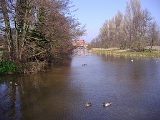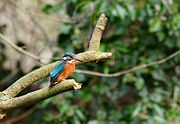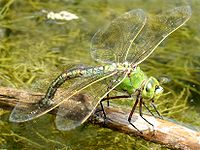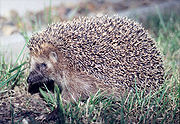
River Glaven
Encyclopedia
The River Glaven is 10½ miles long and flows through picturesque North Norfolk
countryside. Rising from a tiny headwater in Bodham
the river starts just 2 miles before Selbrigg Pond where three streams combine at the outfall. The scenic value of the Glaven valley is important to the tourist industry in North Norfolk
.
has a catchment area of approximately 115 km² and from its source falls 50 metres to the present tidal limit at Cley
sluice. The sub-surface geology is predominantly chalk and in parts of the lower valley the river runs over chalk beds. The land adjoining the river consists of a mixture of arable farm land and in the upper reaches near Edgefield
, coniferous plantations. In the middle reaches there are grazing meadows and low-lying washlands especially below Glandford Mill. There are two major tributaries to the Glaven. Stody beck joins just above Hunworth Mill (Map Ref TG 066 356), and the Thornage Beck which joins close to the unbridged ford on the Thornage to Hunworth road (Map Ref TG 062 363).
.jpg)
Hall Lake and Bayfield Hall Lake. The long, thin lake at Bayfield Hall in many ways epitomises the beauty of the lower Glaven valley. It was dug in the late eighteenth century for ornamental purposes. In the late nineteenth century an ‘extravaganza’ tunnel was built into the valley
side so that the Glaven could be partly diverted around the lake. This tunnel
remains operational.
Together the mills and on-stream lakes give the river a ‘stepped’ profile with, slower flowing ‘ponded’ sections upstream of these structures. Lower down the river at Glandford the river also pools just above the mill, a popular spot for the public.
s: in order of river descent they are Hempstead, near Holt, Norfolk [Hempstead], Hunworth, Thornage, Letheringsett, Letheringsett Brewery mill and Glandford. One of them, Letheringsett, is still in use and is the only working mill in Norfolk
. Here they grind corn to make flour which is on sale at the shop.
are absent as otter
s are thought not to tolerate them. Both red deer
and roe deer
are seen.
The bird population reflects the range of habitats available, and the total number of species present is around 126, of which 68 have bred (these figures do not include birds of the coastal wetlands north of the coast road (A 149
) at Cley). Birds seen include kingfisher
Birds seen include kingfisher
, barn owl
, common buzzard
and osprey
. The latter uses the Glaven Valley as a flyway on its spring and autumn migration and it also sometimes stays to fish. Common buzzard
breed in small but increasing numbers and can be seen wheeling overhead. Barn owls frequently hunt during daylight hours. As winter approaches flocks of pink-footed geese and brent geese fly from the coast to feeding grounds on the farms inland.
, Bull head ,Stone loach
, Brown trout
, Sea trout, Brook lamprey
, Roach
, Rudd
, Perch
, Eel
, Pike, Gudgeon
, Carp
and Tench
.
 Some insects and dragonfly
Some insects and dragonfly
include Banded Demoiselle, Emerald Damselfly
, Scarce Emerald Damselfly, Large Red Damselfly, Red-eyed Damselfly, Small Red-eyed Damselfly, Azure Damselfly , Common Blue Damselfly , Blue-tailed Damselfly , Migrant Hawker , Southern Hawker, Brown Hawker , Emperor Dragonfly , Four-spotted Chaser , Broad-bodied Chaser , Black-tailed Skimmer , Keeled Skimmer
, Common Darter
, Ruddy Darter , Common Hawker, Norfolk Hawker , Hairy Dragonfly, Red-veined Darter , Yellow-winged Darter , Black Darter and the Variable Damselfly.
 Small mammals seen include Hedgehog
Small mammals seen include Hedgehog
, Mole
, Common Shrew
, Pygmy Shrew
, Water Shrew
, Noctule Bat, Pipistrelle Bat, Natterer’s Bat, Daubenton’s Bat, Rabbit
s, Brown Hares
, Grey Squirrel
, Bank Vole
, Short-tailed Field Vole, Water Vole, Wood Mouse
, House Mouse and the Brown Rat
.
, Roe Deer
, Muntjac
, Red Fox
, Badger
, Otter
, Stoat
, Weasel
and Feral cat
s.
North Norfolk
North Norfolk is a local government district in Norfolk, United Kingdom. Its council is based in Cromer. The council headquarters can be found approximately out of the town of Cromer on the Holt Road.-History:...
countryside. Rising from a tiny headwater in Bodham
Bodham
Bodham is a civil parish in the English county of Norfolk.The village is 27.2 miles north north west of Norwich, 6.4 miles west of Cromer and 131 miles north north east of London. The village lies 3.1 miles south west of the nearest town of Sheringham.The nearest railway station is at Sheringham...
the river starts just 2 miles before Selbrigg Pond where three streams combine at the outfall. The scenic value of the Glaven valley is important to the tourist industry in North Norfolk
North Norfolk
North Norfolk is a local government district in Norfolk, United Kingdom. Its council is based in Cromer. The council headquarters can be found approximately out of the town of Cromer on the Holt Road.-History:...
.
Geography
The riverRiver
A river is a natural watercourse, usually freshwater, flowing towards an ocean, a lake, a sea, or another river. In a few cases, a river simply flows into the ground or dries up completely before reaching another body of water. Small rivers may also be called by several other names, including...
has a catchment area of approximately 115 km² and from its source falls 50 metres to the present tidal limit at Cley
Cley next the Sea
Cley next the Sea is a village on the River Glaven in Norfolk, England, 4 miles north-west of Holt and east of Blakeney. The main A149 coast road runs through the centre of the village, causing congestion in the summer months due to the tight, narrow streets. It lies within the Norfolk Coast AONB...
sluice. The sub-surface geology is predominantly chalk and in parts of the lower valley the river runs over chalk beds. The land adjoining the river consists of a mixture of arable farm land and in the upper reaches near Edgefield
Edgefield, Norfolk
Edgefield is a village and a civil parish in the English county of Norfolk. The village is east-north-east of the town of Fakenham, west-south-west of Cromer and north-north-east of London. The nearest town is Holt which lies north of the village. The nearest railway station is at Sheringham...
, coniferous plantations. In the middle reaches there are grazing meadows and low-lying washlands especially below Glandford Mill. There are two major tributaries to the Glaven. Stody beck joins just above Hunworth Mill (Map Ref TG 066 356), and the Thornage Beck which joins close to the unbridged ford on the Thornage to Hunworth road (Map Ref TG 062 363).
.jpg)
Lakes and pools
There are three ‘on-stream’ lakes associated with the main channel, these being Hawksmere (Hempstead mill pond), EdgefieldEdgefield, Norfolk
Edgefield is a village and a civil parish in the English county of Norfolk. The village is east-north-east of the town of Fakenham, west-south-west of Cromer and north-north-east of London. The nearest town is Holt which lies north of the village. The nearest railway station is at Sheringham...
Hall Lake and Bayfield Hall Lake. The long, thin lake at Bayfield Hall in many ways epitomises the beauty of the lower Glaven valley. It was dug in the late eighteenth century for ornamental purposes. In the late nineteenth century an ‘extravaganza’ tunnel was built into the valley
Valley
In geology, a valley or dale is a depression with predominant extent in one direction. A very deep river valley may be called a canyon or gorge.The terms U-shaped and V-shaped are descriptive terms of geography to characterize the form of valleys...
side so that the Glaven could be partly diverted around the lake. This tunnel
Tunnel
A tunnel is an underground passageway, completely enclosed except for openings for egress, commonly at each end.A tunnel may be for foot or vehicular road traffic, for rail traffic, or for a canal. Some tunnels are aqueducts to supply water for consumption or for hydroelectric stations or are sewers...
remains operational.
Together the mills and on-stream lakes give the river a ‘stepped’ profile with, slower flowing ‘ponded’ sections upstream of these structures. Lower down the river at Glandford the river also pools just above the mill, a popular spot for the public.
Watermills
At the time of the Domesday book the River Glaven had 19 watermills. Today the Glaven has six watermillWatermill
A watermill is a structure that uses a water wheel or turbine to drive a mechanical process such as flour, lumber or textile production, or metal shaping .- History :...
s: in order of river descent they are Hempstead, near Holt, Norfolk [Hempstead], Hunworth, Thornage, Letheringsett, Letheringsett Brewery mill and Glandford. One of them, Letheringsett, is still in use and is the only working mill in Norfolk
Norfolk
Norfolk is a low-lying county in the East of England. It has borders with Lincolnshire to the west, Cambridgeshire to the west and southwest and Suffolk to the south. Its northern and eastern boundaries are the North Sea coast and to the north-west the county is bordered by The Wash. The county...
. Here they grind corn to make flour which is on sale at the shop.
Wildlife
Water voles are present in the Glaven, in good numbers. Otters are difficult to see, but they make good use of the river. This could be one reason why minkMink
There are two living species referred to as "mink": the European Mink and the American Mink. The extinct Sea Mink is related to the American Mink, but was much larger. All three species are dark-colored, semi-aquatic, carnivorous mammals of the family Mustelidae, which also includes the weasels and...
are absent as otter
Otter
The Otters are twelve species of semi-aquatic mammals which feed on fish and shellfish, and also other invertebrates, amphibians, birds and small mammals....
s are thought not to tolerate them. Both red deer
Red Deer
The red deer is one of the largest deer species. Depending on taxonomy, the red deer inhabits most of Europe, the Caucasus Mountains region, Asia Minor, parts of western Asia, and central Asia. It also inhabits the Atlas Mountains region between Morocco and Tunisia in northwestern Africa, being...
and roe deer
Roe Deer
The European Roe Deer , also known as the Western Roe Deer, chevreuil or just Roe Deer, is a Eurasian species of deer. It is relatively small, reddish and grey-brown, and well-adapted to cold environments. Roe Deer are widespread in Western Europe, from the Mediterranean to Scandinavia, and from...
are seen.
The bird population reflects the range of habitats available, and the total number of species present is around 126, of which 68 have bred (these figures do not include birds of the coastal wetlands north of the coast road (A 149
A149 road
The A149 is a major route in Norfolk, linking Kings Lynn to Great Yarmouth. It runs via the coast rather than on a more direct route such as the A47. The eastern section runs through The Broads.-Kings Lynn to Wells next the Sea:...
) at Cley).

Kingfisher
Kingfishers are a group of small to medium sized brightly coloured birds in the order Coraciiformes. They have a cosmopolitan distribution, with most species being found in the Old World and Australia...
, barn owl
Barn Owl
The Barn Owl is the most widely distributed species of owl, and one of the most widespread of all birds. It is also referred to as Common Barn Owl, to distinguish it from other species in the barn-owl family Tytonidae. These form one of two main lineages of living owls, the other being the typical...
, common buzzard
Buzzard
A buzzard is one of several large birds, but there are a number of meanings as detailed below.-Old World:In the Old World Buzzard can mean:* One of several medium-sized, wide-ranging raptors with a robust body and broad wings....
and osprey
Osprey
The Osprey , sometimes known as the sea hawk or fish eagle, is a diurnal, fish-eating bird of prey. It is a large raptor, reaching more than in length and across the wings...
. The latter uses the Glaven Valley as a flyway on its spring and autumn migration and it also sometimes stays to fish. Common buzzard
Common Buzzard
The Common Buzzard is a medium to large bird of prey, whose range covers most of Europe and extends into Asia. It is usually resident all year, except in the coldest parts of its range, and in the case of one subspecies.-Description:...
breed in small but increasing numbers and can be seen wheeling overhead. Barn owls frequently hunt during daylight hours. As winter approaches flocks of pink-footed geese and brent geese fly from the coast to feeding grounds on the farms inland.
Fish
Fish in the river include Three spined sticklebackStickleback
The Gasterosteidae are a family of fish including the sticklebacks. FishBase currently recognises sixteen species in the family, grouped in five genera. However several of the species have a number of recognised subspecies, and the taxonomy of the family is thought to be in need of revision...
, Bull head ,Stone loach
Loach
Loach may refer to:* Loaches, fish families in the Cypriniformes:** Cobitidae, the "true" loaches – formerly all loaches were united in this family** Balitoridae, the hillstream loaches – the largest family, closely related to Cobitidae...
, Brown trout
Brown trout
The brown trout and the sea trout are fish of the same species....
, Sea trout, Brook lamprey
Brook lamprey
The European brook lamprey is a small European lamprey species that exclusively inhabits freshwater...
, Roach
Rutilus
Rutilus is a genus of fishes in the family Cyprinidae, commonly called roaches. Locally, the name "roach" without any further qualifiers is also used for particular species, particularly the Common Roach Rutilus (Latin for "shining, red, golden, auburn") is a genus of fishes in the family...
, Rudd
Rudd
The common rudd Scardinius erythropthalmus is a bentho-pelagic freshwater fish, widely spread in Europe and middle Asia, around the basins of the North, Baltic, Black, Caspian and Aral seas.-Artificially introduced:...
, Perch
Perch
Perch is a common name for fish of the genus Perca, freshwater gamefish belonging to the family Percidae. The perch, of which there are three species in different geographical areas, lend their name to a large order of vertebrates: the Perciformes, from the Greek perke meaning spotted, and the...
, Eel
Eel
Eels are an order of fish, which consists of four suborders, 20 families, 111 genera and approximately 800 species. Most eels are predators...
, Pike, Gudgeon
Gudgeon
A gudgeon is a circular fitting, often made of metal, which is affixed to a surface. It allows for the pivoting of another fixture. It is generally used with a pintle, which is a pin which pivots in the hole in the gudgeon. As such, a gudgeon is a simple bearing.-Winged gudgeons:A winged gudgeon...
, Carp
Carp
Carp are various species of oily freshwater fish of the family Cyprinidae, a very large group of fish native to Europe and Asia. The cypriniformes are traditionally grouped with the Characiformes, Siluriformes and Gymnotiformes to create the superorder Ostariophysi, since these groups have certain...
and Tench
Tench
The tench or doctor fish is a freshwater and brackish water fish of the cyprinid family found throughout Eurasia from Western Europe including the British Isles east into Asia as far as the Ob and Yenisei Rivers. It is also found in Lake Baikal...
.
Insects & dragonflies

Dragonfly
A dragonfly is a winged insect belonging to the order Odonata, the suborder Epiprocta or, in the strict sense, the infraorder Anisoptera . It is characterized by large multifaceted eyes, two pairs of strong transparent wings, and an elongated body...
include Banded Demoiselle, Emerald Damselfly
Damselfly
Damselflies are insects in the order Odonata. Damselflies are similar to dragonflies, but the adults can be distinguished by the fact that the wings of most damselflies are held along, and parallel to, the body when at rest...
, Scarce Emerald Damselfly, Large Red Damselfly, Red-eyed Damselfly, Small Red-eyed Damselfly, Azure Damselfly , Common Blue Damselfly , Blue-tailed Damselfly , Migrant Hawker , Southern Hawker, Brown Hawker , Emperor Dragonfly , Four-spotted Chaser , Broad-bodied Chaser , Black-tailed Skimmer , Keeled Skimmer
Keeled Skimmer
The Keeled Skimmer, Orthetrum coerulescens, is a species of European dragonfly. This species resembles the Black-tailed Skimmer but is slimmer and the male has no black tip. Females and immature males lack the black abdominal pattern...
, Common Darter
Common Darter
The Common Darter is a dragonfly of the family Libellulidae native to Eurasia. It is one of the most common dragonflies in Europe, occurring in a wide variety of water bodies, though with a preference for breeding in still water such as ponds and lakes...
, Ruddy Darter , Common Hawker, Norfolk Hawker , Hairy Dragonfly, Red-veined Darter , Yellow-winged Darter , Black Darter and the Variable Damselfly.
Small mammals

Hedgehog
A hedgehog is any of the spiny mammals of the subfamily Erinaceinae and the order Erinaceomorpha. There are 17 species of hedgehog in five genera, found through parts of Europe, Asia, Africa, and New Zealand . There are no hedgehogs native to Australia, and no living species native to the Americas...
, Mole
Mole (animal)
Moles are small cylindrical mammals adapted to a subterranean lifestyle. They have velvety fur; tiny or invisible ears and eyes; and short, powerful limbs with large paws oriented for digging. The term is especially and most properly used for the true moles, those of the Talpidae family in the...
, Common Shrew
Common Shrew
The Common Shrew or Eurasian Shrew, Sorex araneus, is the most common shrew, and one of the most common mammals, throughout Northern Europe, including Great Britain, but excluding Ireland. It is long and weighs , and has velvety dark brown fur with a pale underside. Juvenile shrews have lighter...
, Pygmy Shrew
Eurasian pygmy shrew
The Eurasian Pygmy Shrew , often known simply as the Pygmy Shrew, is a widespread shrew of northern Eurasia. It is the only shrew native to Ireland....
, Water Shrew
Eurasian Water Shrew
The Eurasian Water Shrew, Neomys fodiens, known in the United Kingdom as the Water Shrew, is a relatively large shrew, up to long, with a tail up to three-quarters as long again. It has short dark fur, often with a few white tufts, a white belly, and a few stiff hairs around the feet and tail...
, Noctule Bat, Pipistrelle Bat, Natterer’s Bat, Daubenton’s Bat, Rabbit
Rabbit
Rabbits are small mammals in the family Leporidae of the order Lagomorpha, found in several parts of the world...
s, Brown Hares
European Hare
The European hare , also known as the brown hare, Eastern Jackrabbit and Eastern prairie hare, is a species of hare native to northern, central, and western Europe and western Asia. It is a mammal adapted to temperate open country. It is related to the similarly appearing rabbit, which is in the...
, Grey Squirrel
Eastern Gray Squirrel
The eastern gray squirrel is a tree squirrel in the genus Sciurus native to the eastern and midwestern United States, and to the southerly portions of the eastern provinces of Canada...
, Bank Vole
Vole
A vole is a small rodent resembling a mouse but with a stouter body, a shorter hairy tail, a slightly rounder head, smaller ears and eyes, and differently formed molars . There are approximately 155 species of voles. They are sometimes known as meadow mice or field mice in North America...
, Short-tailed Field Vole, Water Vole, Wood Mouse
Wood mouse
The wood mouse is a common murid rodent from Europe and northwestern Africa. It is closely related to the yellow-necked mouse but differs in that it has no band of yellow fur around the neck, has slightly smaller ears, and is usually slightly smaller overall: around 90 mm in length...
, House Mouse and the Brown Rat
Brown Rat
The brown rat, common rat, sewer rat, Hanover rat, Norway rat, Brown Norway rat, Norwegian rat, or wharf rat is one of the best known and most common rats....
.
Larger mammals
Red DeerRed Deer
The red deer is one of the largest deer species. Depending on taxonomy, the red deer inhabits most of Europe, the Caucasus Mountains region, Asia Minor, parts of western Asia, and central Asia. It also inhabits the Atlas Mountains region between Morocco and Tunisia in northwestern Africa, being...
, Roe Deer
Roe Deer
The European Roe Deer , also known as the Western Roe Deer, chevreuil or just Roe Deer, is a Eurasian species of deer. It is relatively small, reddish and grey-brown, and well-adapted to cold environments. Roe Deer are widespread in Western Europe, from the Mediterranean to Scandinavia, and from...
, Muntjac
Muntjac
Muntjac, also known as Barking Deer and Mastreani Deer, are small deer of the genus Muntiacus. Muntjac are the oldest known deer, appearing 15–35 million years ago, with remains found in Miocene deposits in France, Germany and Poland....
, Red Fox
Red Fox
The red fox is the largest of the true foxes, as well as being the most geographically spread member of the Carnivora, being distributed across the entire northern hemisphere from the Arctic Circle to North Africa, Central America, and the steppes of Asia...
, Badger
Badger
Badgers are short-legged omnivores in the weasel family, Mustelidae. There are nine species of badger, in three subfamilies : Melinae , Mellivorinae , and Taxideinae...
, Otter
Otter
The Otters are twelve species of semi-aquatic mammals which feed on fish and shellfish, and also other invertebrates, amphibians, birds and small mammals....
, Stoat
Stoat
The stoat , also known as the ermine or short-tailed weasel, is a species of Mustelid native to Eurasia and North America, distinguished from the least weasel by its larger size and longer tail with a prominent black tip...
, Weasel
Weasel
Weasels are mammals forming the genus Mustela of the Mustelidae family. They are small, active predators, long and slender with short legs....
and Feral cat
Feral cat
A feral cat is a descendant of a domesticated cat that has returned to the wild. It is distinguished from a stray cat, which is a pet cat that has been lost or abandoned, while feral cats are born in the wild; the offspring of a stray cat can be considered feral if born in the wild.In many parts of...
s.

